The Brooklyn Comics and Graphics Festival this year was, by all accounts, pretty crowded and hot in the main building, but the governing factor was high attendance, and the discussion panels, held at The Knitting Factory, also confirmed the trend. They were highly attended, and for the most part, standing room only. This signals a need for expansion in venues for BCGF, and on the whole has to be taken as a positive sign. Just like SPX and NYCC this year, attendance and participation at comics events is on the rise, and that means good sales and good press. The first panel of the festival was almost certainly the most in demand. Chris Ware, Richard McGuire, and Art Spiegelman getting together to talk about the architecture of comics was an easy sell at a free event. Lines started forming an hour ahead of time and the staff at The Knitting Factory had to think fast to find a way to accommodate the large number of fans who showed up. All hopefuls who were present a little ahead of the 11 o’clock start time got into the panel, but the rather gracious and helpful staff rigged up a sound system in the bar for those arriving later who didn’t make it in.
Fans got an earful of what they were hoping for: a lively conversation among three comics greats, moderated by BCGF event organizer Bill Kartalopoulos, about their work and philosophies, and Ware’s recent BUILDING STORIES box of mixed media and McGuire’s upcoming work received plenty of discussion. Ware’s initial comments on BUILDING STORIES suggested that he thinks traditional sequential narrative with a “beginning and end” is in many ways a “masculine form” whereas BUILDING STORIES introduces a more feminine aspect of permeability in interpretation and participation. Spiegelman jumped in to praise BUILDING STORIES as a “paradigm shifting” work, and he feels that Ware is currently raising the bar on the comics medium. Spiegelman agreed that the “first wave of graphic novels”, including his seminal work MAUS were both masculine and adult, containing plenty of subject matter that publishers felt was “good for you” and “what you should know”. Spiegelman feels that this is limiting to the medium and that introducing a wider definition of the “fictive” can create a “larger” experience for the reader, allowing “subtlety”, like BUILDING STORIES. McGuire agreed that “interactive” comics are the way of the future, and Ware reminded the audience that books themselves are “innately interactive”, a feature highlighted in magazines like RAW, which have heavily influenced him.
Kartalopoulos led the panelists into a discussion of the philosophies behind their artistic production, and whether they tended toward a “macroscopic” view of the world. Ware referred again to a tradition, often overlooked, in comics that dates back to early cartoon composition wherein page composition often suggested large settings and each page was constructed as an artistic whole. Spiegelman prefers to go back to dictionary definitions of “comics”, he said, including associations behind the word “story”. Investigating this led Spiegelman to consider the stained-glass windows of medieval churches, a story-telling format that still impacts his idea of narrative. Stained glass windows, he explained, were meant to be viewed as a whole before “components” were broken down for communication, just like a comics page, and even suggest that comics “chronologies” of left to right are not sacred. All of the panelists enthused about the early “broadsheet” format of many comics, a “scale” rarely comprehended by readers when picking up reprints. For instance, Spiegelman’s IN THE SHADOW OF NO TOWERS, he introduces macrocosmic scale back into comics.
McGuire’s work HERE, which originally appeared in RAW in 1989 and is now being developed into a book, experiments with space and time with a backward and forward axis that uses architecture to suggest the “transient nature of everything”, including glaciers and an “underwater era” for the same location: the house where he grew up. McGuire is currently experimenting with watercolors to flesh out panels while perusing family photos where the fading colors and the colors of photography during certain eras, for him, express locations in time. He wowed the audience with images and image-lapsing videos of panels from his work under construction, including the ingenious feature of using the gutter of the book as the focal point of the “corner” of the room where all of the work’s scenes take place. This draws the reader into an experience of the space. Kartalopoulos commented that works like McGuire’s were turning comics into “4th dimensional chess at this point”, eliciting a hearty round of applause from the crowd.
Ware added that his goals are all about experience and reaction when it comes to BUILDING STORIES. He wants a “non-intellectual response” from readers, and encourages the impulse to feel and touch the artifact itself. Both McGuire and Ware feel that “reducing” the language of the visual is the key to decoding and unlocking it for the reader. Spiegelman was more skeptical about the role of digital media in this reduction. With the IPad becoming “performance art” to Spiegelman, he’s concerned that digital sequential narrative is going to become encoded in formats that become obsolete quickly, and then their content will be lost to future generations. He cited a CD ROM of MAUS that he worked on in the 1990’s that now is unreadable and unusable, “more of a lost language than Aramaic” now. Spiegelman, with upbeat resignation concluded “It’s all going to be DUST, so just relax about it, especially in electronic media”, which provoked laughter despite the statement’s heavy truths.
Spiegelman also introduced images from his recent four-year-long stained-glass window project for his old high school to the audience, a project that certainly brings comics and architecture together in astonishing ways. Attempting to tell the story of the school’s “yesterday, today, and tomorrow” took Spiegelman into challenging territory, attempting to blow his sketches up to a large scale. He wanted the images to be “friendly, like in a kindergarten”, but also “open up further” upon investigation. He learned how to use new computer technology to blow up his images to the macro, and included both translucent and opaque panels so students could view down through the windows into a cafeteria from an upper level. Ware interrupted Spiegelman’s self-effacing commentary on his personal art style with the simple declaration, “You really CAN draw”. Spiegelman laughed but continued to speak equivocally about his “native cartooning style” that hampered his progress on the window project. Spiegelman reminded fans that drafting MAUS required him to draw each page “a hundred times” to achieve a style “between handwriting and typography”.
Kartalopoulos projected images of Ware’s own blueprint sketches for BUILDING STORIES. The blueprints reflected Ware’s own methodical measures in getting his style for the opus just right, a style Ware described as “synthetic”. He was most concerned, he said, with keeping the individual images from being “too interesting”, which would cause readers to spend “too much time” on each rather than taking in the world being presented to them. The panel discussion confirmed a similarity between the works of Ware, McGuire, and Spiegelman: they are all world-builders who use elements of style and design in story-telling construction to convey imaginative realities well beyond the page. Their works become a conceptual experience through the architectures they build.
Bringing Ware, McGuire, and Spiegelman together was an energizing start to the Brooklyn Comics and Graphics Festival, and suggested that the festival itself was a place where big ideas are welcome. Plenty of those who didn’t make it to the panel also got the thrill of seeing these now legendary creators wandering around the floor making their own purchases and keeping tabs on emerging new ideas in visual storytelling.
Hannah Means-Shannon writes and blogs about comics for TRIP CITY and Sequart.org and is currently working on books about Neil Gaiman and Alan Moore for Sequart. She is @hannahmenzies on Twitter and hannahmenziesblog on WordPress.




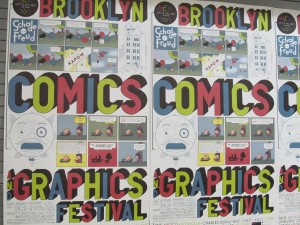
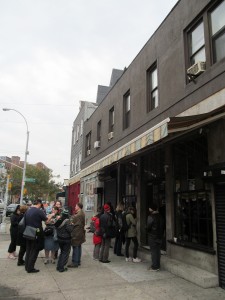
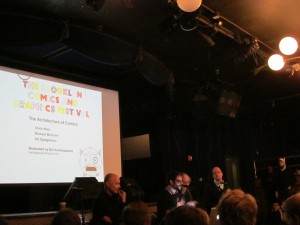
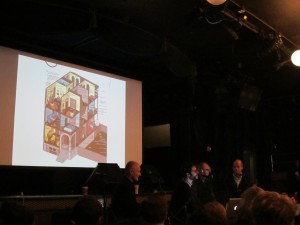


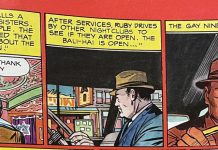






Great writeup, Hannah. This was an important and exciting conversation. i greatly appreciate how your thoughtful documentation gives it “legs” so to speak, so that others can continue to reflect on and reconsider the possibilities for expression in this medium. Thanks.
Why is it necessary to capitalize BUILDING STORIES?
All writers build stories … The linear approach is one method.
Jessica Lee liked this on Facebook.
Katie Cosmonaut liked this on Facebook.
Comments are closed.